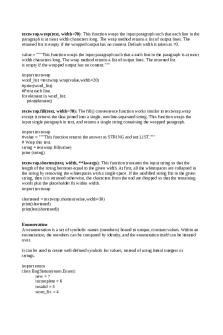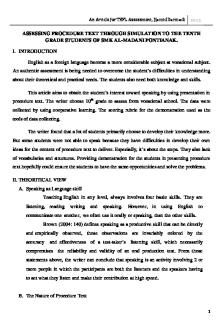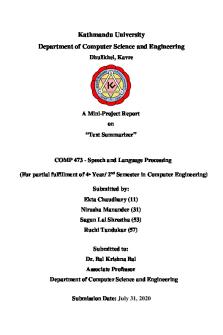ASSESSING SPEAKING ABILITY BY USING SIMULATION TECHNIQUE IN PROCEDURE TEXT PDF

| Title | ASSESSING SPEAKING ABILITY BY USING SIMULATION TECHNIQUE IN PROCEDURE TEXT |
|---|---|
| Author | Hamid Darmadi |
| Pages | 7 |
| File Size | 70 KB |
| File Type | |
| Total Downloads | 115 |
| Total Views | 236 |
Summary
An Article for TEFL Assessment, Hamid Darmadi ASSESSING PROCEDURE TEXT THROUGH SIMULATION TO THE TENTH GRADE STUDENTS OF SMK AL-MADANI PONTIANAK. I. INTRODUCTION English as a foreign language become a more considerable subject at vocational subject. An authentic assessment is being needed to overcom...
Description
An Article for TEFL Assessment, Hamid Darmadi
ASSESSING PROCEDURE TEXT THROUGH SIMULATION TO THE TENTH GRADE STUDENTS OF SMK AL-MADANI PONTIANAK. I. INTRODUCTION English as a foreign language become a more considerable subject at vocational subject. An authentic assessment is being needed to overcome the student’s difficulties in understanding about their theoretical and practical needs. The students also need both knowledge and skills. This article aims to obtain the student’s interest toward speaking by using presentation in procedure text. The writer choose 10th grade to assess from vocational school. The data were collected by using cooperative learning. The scoring rubric for the demonstration used as the tools of data collecting. The writer found that a lot of students primarily choose to develop their knowledge more. But some students were not able to speak because they have difficulties in develop their own ideas for the content of procedure text to deliver. Especially, it’s about the steps. They also lack of vocabularies and structures. Providing demonstration for the students in presenting procedure text hopefully could ensure the students to have the same opportunities and solve the problems. II. THEORITICAL VIEW A. Speaking as Language skill Teaching English in any level, always involves four basic skills. They are listening, reading
writing
and
speaking.
However, in
using
English
to
communicate one another, we often use it orally or speaking, than the other skills. Brown (2004: 140) defines speaking as a productive skill that can be directly and empirically observed, those observations are invariably colored by the accuracy
and effectiveness of a test-taker’s listening skill, which necessarily
compromises the reliability and validity of an oral production test. From those statements above, the writer can conclude that speaking is an activity involving 2 or more people in which the participants are both the listeners and the speakers having to act what they listen and make their contribution at high speed.
B. The Nature of Procedure Text 1
An Article for TEFL Assessment, Hamid Darmadi
One factor which accounts for differences in text is the purpose for which the text is being used. When constructing a piece of text, the writer makes choice of words will depend again on the purpose and context of the text. Procedure text is common factual genres that provide instructions on how to do something. Further, Anderson & Kathy (1998: 2) explain that a procedure is a piece of text that tells the reader or listener how to do something. The purpose of procedure text is to provide sequenced information or directions so that people can successfully perform activities in safe, efficient, and appropriate ways. Procedure text is already familiar with people’s daily life, for example in giving instructions to make something, in games rules, in recipes, manual steps, directions of destination (Derewianka. 2004: 23-27). The context consists of three parts: a. Title/goal b. List of material c. Steps/method/procedures To arrange a good procedure text, we need the common text organization that should be applied in writing procedure text. Derewianka (1995: 27) mentions, the text organization of a procedure text as follows: a. The focus of instructional texts is on a sequence of actions b. The structure is easily recognized c. Each stage serves a particular function d. The text may also include comments on the usefulness, significance, danger, fun, etc. e. Headings, subheadings, numbers, diagrams, and photos are often utilized to make instruction as clear and easy to understand as possible.
C. The Use of Demonstration as Technique in Language Teaching Before further information, the writer would like to present the definitions of demonstration:
2
An Article for TEFL Assessment, Hamid Darmadi
a. Demonstration is away to show how to do something step by step so that the students can learn new skills and how to do something themselves (Barclay & Vynckt, 1984). b. Demonstration is a way to represent the subject by showing the objects directly or a way to do something by showing its process (Joesof Djajasastra, 1982).
From some of definition above, we can conclude that demonstration is a medium used in the teaching-learning process to show something by using object directly. Most of the students often face difficulties when they perform to speak. One of the reasons that make them difficult to speak is because they sometimes do not have appropriate time to practicing speaking outside their class. This situation also will be a challenge for the teacher to make the activity of writing becomes attractive and enjoyable.
III. THE CONCEPT Speaking assessment was used to simulate the material. The simulations were hopefully will make the material more fun and easy to understand. The instructions are: First, the teacher set the classroom into an exhibition situation. Second, the teacher asks the students to have groups. Third, the teacher brainstorms the students and gives them a visual or written sample of procedure text. Forth, the teacher checking their understanding about the generic structure of procedure text, the use of grammar structure, the use of action verbs and any appropriate vocabularies to prepare their simulation. Fifth, the teacher asks the group to have their product/goal. Sixth, the students must prepare their own tools and materials to perform the introduction of their product. Seventh, the teacher asks the group randomly to perform and introduce their product in front of the class. Eighth, the students perform/simulate step by step of how their goal successfully reaches by using the tools and materials to become a product. 3
An Article for TEFL Assessment, Hamid Darmadi
Ninth, After the simulation from the group, the others group will have their discussion to verify and recognize the steps in the real setting of life. Tenth, the students also must find the action verbs which are used in order to simulate the steps. Then finally, the teacher gives the score by the scoring rubric. The scoring rubric for the procedure text is: Components Goals
Points
Description
20
Excellent to very good: Clearly stated the purpose
15
Good to average: Relate to the purpose
10
Fair to poor: May be stated the purpose
5
Very poor: Not clearly stated the purpose
Materials
16 - 20
Excellent to very good: performing the material and the tool used
Needed
11 - 15
Good to average: performing some of the material and the tool
6 - 10
Fair to poor: performing only the material or the tool
0-5
Very poor: not performing the material and the tool
The Steps
Present Tense
16 - 20
Excellent to very good: simulate the step orderly
11 - 15
Good to average: simulate the step almost orderly
6 - 10
Fair to poor: simulate the step less order
0-5
Very poor: simulate the step not in order
16 - 20
Excellent to very good: correct in using simple present tense
11 - 15
Good to average: mostly correct in using simple present tense
6 - 10
Fair to poor: often incorrect in using simple present tense
0-5
Very poor: many errors correct in using simple present tense
Performing
Excellent to very good: Maintains eye contact and pronounces all 16 - 20
terms precisely. All audience members can see. Good to average: Maintains eye contact most of the time and
11 - 15
pronounces most words correctly. Most audience members can see. Fair to poor: Occasionally uses eye contact, mostly reading presentation, and incorrectly pronounces terms. Audience members
6 - 10
have difficulty hearing. Very poor: Reads with no eye contact and incorrectly pronounces
0-5
terms. Speaks too quietly. 4
An Article for TEFL Assessment, Hamid Darmadi
(Adapted from Heaton, 1988: 96)
IV. The Implementation of Using Simulation as the Assessment in Procedure Text to the Tenth Grade Students of SMK Al-Madani Pontianak. At first, the preparation for teaching before going to the class are the English syllabus and lesson plan for the tenth grade students for vocational high school. It is set correctly based on the KTSP curriculum. The teacher use one class and the students involved in the class are 30 students. The students are set into 6 group consist of five person for each groups. Then, the teacher will brainstorm the students by asking what the previous meeting is about. The teacher already introduced procedure text in the previous meeting. Further, the teacher gives them homework to bring materials needed to present their procedure text by demonstrating the steps in this meeting. The teacher states the purpose of the learning and tells an interesting fact about how to simulate the procedure text in demonstration. In case, the students are able to see the usage of procedure text in the real life which relate to authentic assessment later. After that, the teacher mention the instructions how to demonstrate their procedure text step by step to the students and the scoring criteria. The teacher will help the students by asking them to take a note about several common action verbs used for explain the steps of their procedure text. Next, the students demonstrate their procedure text by using the real setting and real materials the steps were done. Each student in the group will explain about the procedure part by part. For instance, the first students will introduce the title and the materials used for their procedure text, the second students will explain the first steps, the third students will continue for the next steps, the forth students will continue to explain the last step, and the fifth student will help their friends practically. It depends on how many steps do the procedure takes. While presenting their demo, the teacher will record the students in video to see and hear their performance ability in speaking.
5
An Article for TEFL Assessment, Hamid Darmadi
Finally, the teacher will give score for the students based on the table of specification. Both the teacher and the students will discuss their performance after all group presented. The teacher also gives feedback for the evaluation of their speaking and their expressions used in performing the procedure text. V. CONCLUSION In summary, this study is still far from being successful yet. Further research must be taken for better development and improvement. There is various ways for assessment. But the teacher hopes that by using simulation for assessing the procedure text, the students were easy to develop their speaking. It also encourages the students to express speaking more lightly to their friends or to the teacher in daily life or in the learning process.
VI. REFERENCES Anderson, Mark and Anderson. Kathy. (1998). Text Type in English 3. South Yarra: Macmillan Education Australia PTY LTD. Bachman and Alderson. (2004). Assessing Speaking: Sari Luoma. Cambridge: Cambridge University Press. Barclay, Elley J. And Vynckt, Susan Van der. (1984). Easy to Make Teaching Aids for Nutrition Teaching-Learning. Paris: UNESCO Berardo, A.S. (2006). The Use of Authentic Materials in the Teaching of Reading. An Educational Journal, Vol.6, No.2, September 2006. Brown, H.D. (2002). Language Assessment: Principles and Classroom Practices, New York: Longman Press. Brown, H.D. (2004). Language Assessment Principles and Classroom Practices. New York: Pearson Education, Inc. Derewianka, Beverly. (2004). Exploring How Texts Work. Australia: Primary English Teaching Association. Djajasastra, Joesoef. (1982). Metode-Metode Mengajar. Bandung: Angkasa. Heaton, J.B. (1988). Writing English Language Tests. New York: Longman Inc. Phye, D.G. (1997). Handbook of Classroom Assessment: Learning, Adjustment, and Achievement. USA: Academic Press. 6
An Article for TEFL Assessment, Hamid Darmadi
Trapp, G. and Barry, B. (2014). Assessing with role-play and simulation. Australia: UNSW Australia University Document.
7...
Similar Free PDFs

Assessing Speaking Skill : A Summary
- 10 Pages

RPP PROCEDURE TEXT
- 11 Pages

Tutorial Simulation Using Abaqus CAE
- 15 Pages

Mc simulation in python
- 8 Pages

reviewer-in-civil-procedure-
- 60 Pages

Chp #1 - Speaking In Public
- 7 Pages

2.2 Ethics in Public Speaking
- 14 Pages

Text wrap in Python
- 5 Pages
Popular Institutions
- Tinajero National High School - Annex
- Politeknik Caltex Riau
- Yokohama City University
- SGT University
- University of Al-Qadisiyah
- Divine Word College of Vigan
- Techniek College Rotterdam
- Universidade de Santiago
- Universiti Teknologi MARA Cawangan Johor Kampus Pasir Gudang
- Poltekkes Kemenkes Yogyakarta
- Baguio City National High School
- Colegio san marcos
- preparatoria uno
- Centro de Bachillerato Tecnológico Industrial y de Servicios No. 107
- Dalian Maritime University
- Quang Trung Secondary School
- Colegio Tecnológico en Informática
- Corporación Regional de Educación Superior
- Grupo CEDVA
- Dar Al Uloom University
- Centro de Estudios Preuniversitarios de la Universidad Nacional de Ingeniería
- 上智大学
- Aakash International School, Nuna Majara
- San Felipe Neri Catholic School
- Kang Chiao International School - New Taipei City
- Misamis Occidental National High School
- Institución Educativa Escuela Normal Juan Ladrilleros
- Kolehiyo ng Pantukan
- Batanes State College
- Instituto Continental
- Sekolah Menengah Kejuruan Kesehatan Kaltara (Tarakan)
- Colegio de La Inmaculada Concepcion - Cebu







